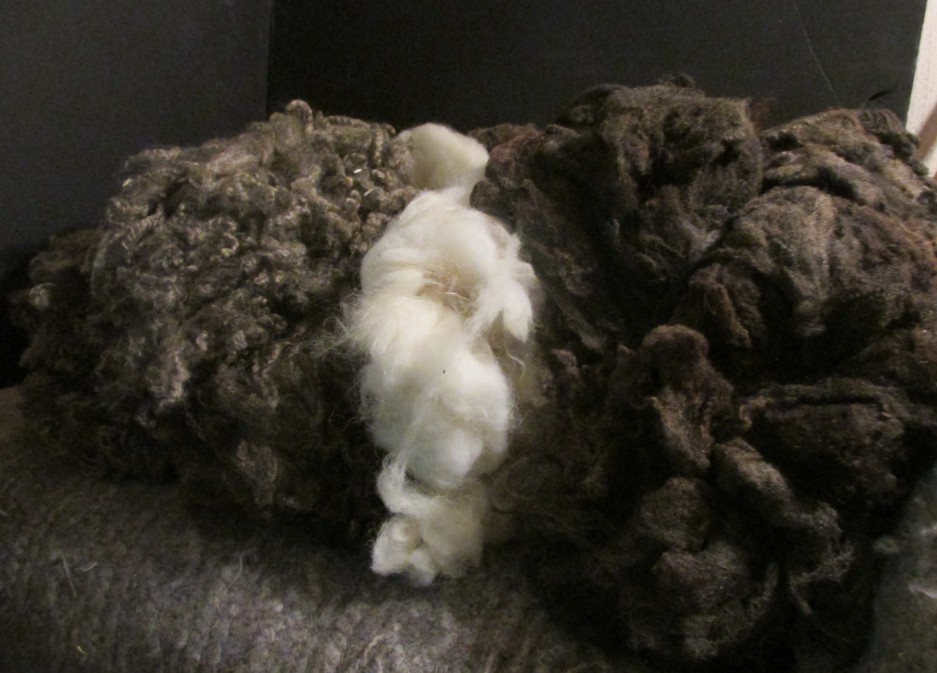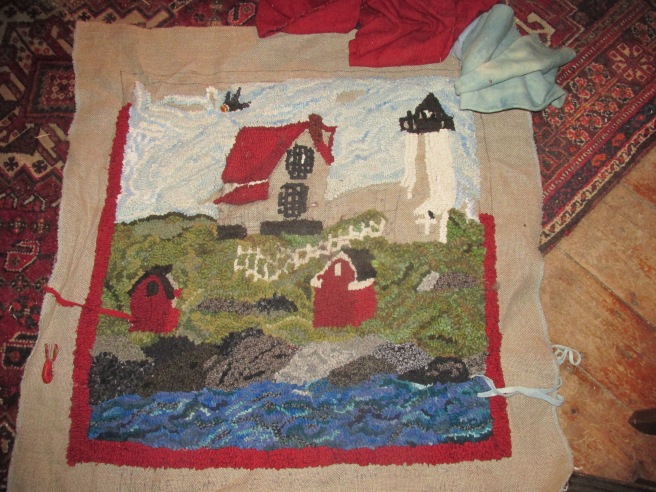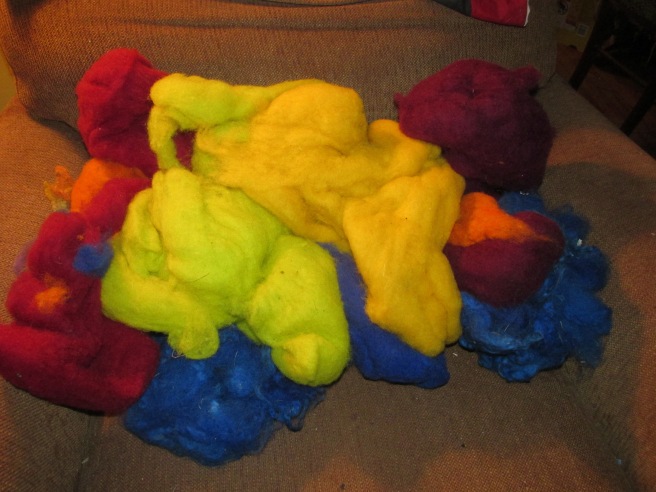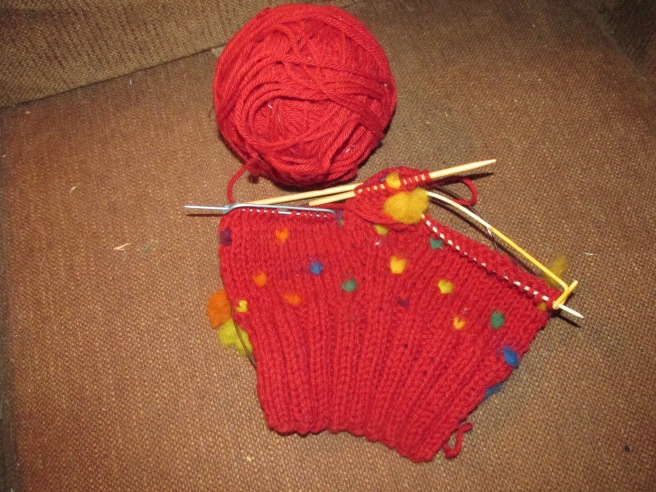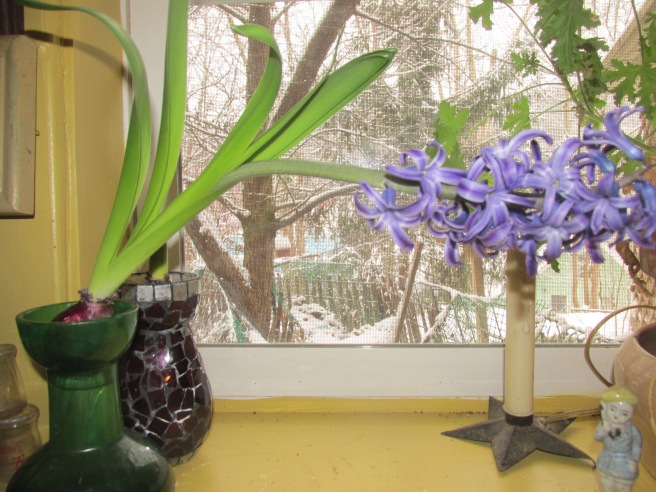First Year In Sheep (almost), and Then Some
It’s February, 2017, and there are seven young Finnsheep up in my barn.
They are currently about 10 months old: five ewes and two rams. Most of them have been here since they were 10 weeks old. Seeing as they are my first ever sheep, it’s been a busy, educational, eight months for me – but to be fair, the education began a long, long time before the sheep arrived.
Reading through FIBERuary, I see that most postings are expositions on pretty specific topics concerning any-of-many aspects of fiber, written by people with loads of experience and practice and time in their fields. I’m essentially a raw beginner, and I’m still surfing the waves of anxiety and doubt that come right along with the excitement of a new venture. I can tell you what setting up a fiber farm has been for me, so far, but I can’t tell you how it will go from here, or where I’ll succeed and where I’ll need to, um, try harder. For folks wondering what goes into starting a fiber venture with animals, I expect that there are as many paths as there are people. Here’s a little view of mine…

Almost three years ago, when we moved to Western Mass from the mid-west, I knew I’d be looking to set up with animals. Though I wasn’t raised in the country, in Minnesota we’d had chickens and horses and land, so I had experience with pastures, tractors, manure piles, frozen water buckets, and the like – enough experience, hopefully, to know what I needed and what I was getting into. We found a property that would be suitable for a small flock and also meet the requirements of the other (human) members of my family. It was time to buckle down and learn what I needed to do.

I tried to learn in whatever ways I could. There were books in the library, books on my bookshelves, magazines and websites. I attended online webinar series (yay! Maryland Sheep&Goat!), fencing seminars, Sheep and Wool Festivals and the workshops they hosted, Jill and Jim H-L’s Sheep-in-a-Day class (yay! pragmatic and hands-on!), Sheep Growers’ Association days. I talked to everyone I encountered who had or had had sheep. I got a spinning wheel and learned how to use it.
I tried to learn something about EVERYTHING, or at least it feels that way. Sheep breeds. Sheep diseases. The structure of wool, the structure of yarn. Fencing types, pros, cons. Livestock guard animals. Fleece processors. Mills. Carcasses. Wholesale cuts, retail cuts. Parasites. Forbes. Electricity. Drum carders. Combing. Picking. Flicking. Sheep reproduction. Scours. Scouring. Netting. Deep bedding. Skirting. Hoof trimming. Hay. Rhododendron, Yew, Mountain Laurel. Antibiotics. SubQ, IM. Drenching. CDT. Selenium. Copper. Hi-tensile knots. Coating. Creep. H. contortus. On and on. And all the while, I knew that I couldn’t really learn husbandry from a book – that at some point, soon, I was going to have to jump in with both feet and make my mistakes and take my knocks.

Getting my infrastructure in place took up the second summer in Massachusetts. My property had lovely hillside pasture, but no fencing or barn. I know that a lot of people run their sheep with portable electric netting alone, but I chose to build a permanent fence – wood posts, woven wire, electrified wires at the top and bottom – and it helps me sleep when the coyotes are singing their crazy songs. My son and I built the entire fence by ourselves, and that is a whole ‘nother story entirely – I can just say that it was a rich learning experience.
Structure-wise, all the sheep would need was a simple shed. But, for me, I built a barn (had it built, truly), one with four walls and doors that close. So now there is a place for the sheep, and room as well to store equipment and hay. And all of us, the ewes and me, will be comfortably out of the wind and wet when lambing time comes. Currently, the barn seems really big, but with luck my estimates were sound, and when my flock reaches its full number, the square footage will be just right – Goldilocks style.
So a year and a half in, I had a barn and a fence and a head full of info, but when it came time to choose a specific breed of sheep, I was adrift. I’d collected an embarrassing number of fleeces and partial fleeces, trying to decide what I liked for handspinning, but nothing was clicking. Or if I liked the fiber, I was finding that the breed was too wild, or too big, or not suited to a Massachusetts climate, or something else that made them not right for my farm. I’d ruled out Finns early on because I didn’t like the sound of “litters of lambs”. One of Finnsheep’s most notable characteristics is their propensity to birth multiple lambs: not just twins, but triplets, quads, and beyond. Despite my reservations, I ended up talking to a Finn breeder at her booth at Rhinebeck in the fall of ’15. She assured me that Finnsheep’s awesome mothering instincts more than made up for the multiples – Finn mothers love their lambs and will not only NOT reject them (which sometimes happens with other breeds), they are even known to steal other ewes’ offspring. This breeder assured me that she didn’t put up with bottle feeding lots of orphans, or “bummer” lambs, and that the sheep did the work. The conversation peaked my curiosity, and soon I was collecting more fleece samples, this time from different Finn farms.

And I loved what I found. Finn fleeces vary, from animal to animal and farm to farm, but they are generally soft and silky, retaining both a good degree of bounce and often remarkable luster. They come in colors – there is a broad palate of blacks, browns, grays and fawns, and patterns – solid, badger (light top, dark under), HST (head, socks, tail) & Piebald. For me, they were fun to spin and easy to prep – not a lot of grease and easy to wash, with fairly uniform staple length and consistency within each fleece. Some samples felted very easily, others not so much, so there is variability in that, too. And beyond the fleece characteristics, I really liked what I found about Finns as a breed: they are medium sized animals, naturally short-tailed so no need for docking, hardy in our climate, used as dual-purpose animals (fiber and meat), and known for their very sweet dispositions. And all those darling babies. It looked like a good match for a new shepherd who would be working solo and wasn’t getting any younger. I picked my favorite sample and placed an order with that breeder, and waited for my lambs.
From the time I picked them up in mid-June, it’s been smooth enough sailing, I think. I can’t say I was prepared for absolutely everything or knew what to do at every turn, but the sheep have been sweet and easy, and so far everybody seems well. We’ve gotten through vaccinations (oh no, needles!), de-worming (not so bad), learning about electric netting (only takes once), separating the boys from the girls (don’t wait too long!), putting them back together (no fireworks to speak of- seems sheep are discreet), and learning to love hay and put up with the dull days of winter. By late summer, I got a llama to serve as sentinel for the flock. Chris took to his new job with surprising conviction, and the lambs took to Chris with surprising affection. As our strange February weather begins to hint at spring and the maple trees get going, the flock’s fleeces are big and thick and I’m looking forward to shearing day, even though it’s clear that I’ll need to get better at keeping the hay out of their wool (dribbly llama, indeed). I’m wondering if the girls will be showing their bellies when the wool comes off. They are young, but Finns are said to be capable mothers even as yearlings, so we’ll see. They certainly tell me they’re hungry enough to be growing lambs, every time I show up in the barn to feed them!
So I was prepared, to the extent I could be, and I am pleased, beyond expectation. All along as well, I’ve been making mistakes: doing things wrong and doing ‘em over. Small stuff, mostly, I think – I’m likely not yet aware of half the mistakes I’ve made so far. Hopefully none of them is critical. And while I hope my sheep are pregnant, I’ll certainly be terrified if, and when, the lambs arrive in a couple of months. In other words, not every day is easy, and not everything is fun. I’ll be glad when I have several seasons of shepherding under my belt, and when every situation is not brand new, another test to pass. But I’m grateful to be learning so much, and to have great people and resources at hand to teach me. I’m grateful as well that this education so far has only scratched the surface: it’s headsmacking to appreciate how much there is that can be known, and learned, and done. If I keep the right attitude I will stay satisfyingly busy until I’m dead. It’s good to have goals.
One thing I wasn’t expecting was how taken I’d be by these animals’ temperaments. I thought sheep would be fairly neutral: interested in grass, grain, and each other, tolerant (I hoped) of their keeper. These sheep are curious, friendly, and sweet as well: I get tail wags and zipper nibbles, they get their faces petted. I always have help with whatever I’m shoveling, or moving, or mending. I don’t know if this is sheep in general, Finnsheep in particular, or just my sheep especially. And for this, I’m not really concerned to find an answer. I’m happy to be these sheep’s shepherd, and I’ll look forward to their mentoring. Here’s thanks to the sheep in the year that’s passed, and thanks to sheep in the years to come!
Marti Ferguson
Buckland, MA, February 2017


